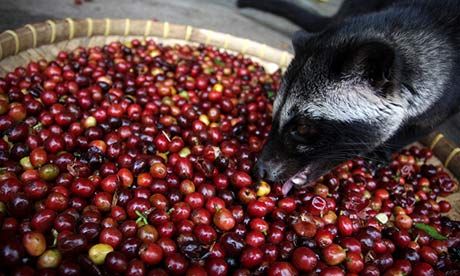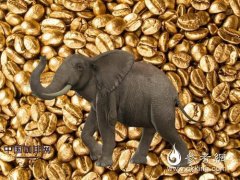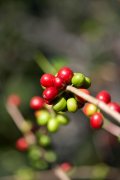The origin of Kopi Luwak was used as a gimmick, no sale, no killing.
The origin of Kopi Luwak has been used as a gimmick and now mostly comes from coconut cats in cages.

But now, it is hard to see the original Kopi Luwak. Today's Kopi Luwak comes mostly from wild coconut cats in cages, and they are generally kept in harsh conditions. A Japanese scientist recently claimed to have invented a way to tell whether coffee beans come from wild coconut cats or captive coconut cats, especially if he can tell whether coffee beans come from wild coconut cats or captive ones.
Many coffee companies around the world are still using the original story about wildlife digestion habits as a stunt to sell Kopi Luwak. Many companies claim that they can only collect 500kg Kopi Luwak a year. And use this scarcity to justify its high price (Kopi Luwak usually sells for $200,400 per kilogram, sometimes more). In fact, although exact figures are not available, I estimate that Kopi Luwak's annual global production is at least 50 tons, much more than that is possible. Now farmers in India, Vietnam, China and the Philippines have joined the production of Kopi Luwak.

An Indonesian farm says it can produce 7000 kilograms of Kopi Luwak a year from 240 caged coconut cats. Photo Source: theguardian.com
four
Now Kopi Luwak has become the product of industrialization, and coconut cats have been treated cruelly.
Today's Kopi Luwak in Indonesia is basically the product of industrial production, and the original ecology is almost impossible. Doesn't that sound a little disgusting? That's true. These timid and solitary creatures have to be huddled in a cage with their own kind, which puts them under great pressure, and an abnormal diet with too much emphasis on coffee fruits also makes them suffer from other health problems. Coconut cats in cages begin to fight with each other, even bite off their legs, feces begin to carry blood, and death is even more common.
In Indonesia, the trapping of wild coconut cats is supposed to be strictly controlled, but they are caged by poachers and forcibly fed with coffee fruits to excrete more feces with coffee beans. and it's all for profiteering and the hypocritical pleasures of some people.
Kopi Luwak's business has been a great success, especially among consumers who spend a lot of money. If you are worried about preparing a birthday present for your tuhao friend, how about spending 6500 pounds on a Kopi Luwak wrapped in 24-karat gold foil at Harrods, the most famous and upscale department store in the UK? In fact, what you buy is no longer Kopi Luwak, just like Thai shit coffee and Brazilian sparrow shit coffee, which are popular all over the world, are just used to satisfy people's insatiable desire for this strange and superficial vanity.

A coconut cat is caged on a farm in Surabaya, Indonesia. Photo Source: theguardian.com
five
Kopi Luwak can't sacrifice wildlife. It's time to stop it.
At the beginning, I made an inadvertent purchase, which led to such incredible progress. At that time I introduced Kopi Luwak to the UK. It was a strange and novel short story, but now it has been overpriced and over-industrialised. People use it to cover themselves with a veil of hypocrisy to whitewash their abnormal taste and senseless vanity. I hope everyone can think about it, to satisfy their own interest can not be at the expense of wild animals, this cancer can no longer continue, it is time to stop.
Important Notice :
前街咖啡 FrontStreet Coffee has moved to new addredd:
FrontStreet Coffee Address: 315,Donghua East Road,GuangZhou
Tel:020 38364473
- Prev

The whole process analysis of elephant dung coffee, expensive Thai coffee
Coffee is called "black gold" for a reason, just look at Taiwan now whether convenience stores or supermarkets can buy coffee at any time you know the potential of "black gold", creating business opportunities to be scary. But top coffee. Do you know how much you can get for a cup? The answer is $1500 a cup. Can you imagine yourself drinking a $1500 cup of coffee? And this coffee.
- Next

Yunnan Coffee suffers from the embarrassment of increasing production but not increasing income of Coffee beans grown in China
It is the 2015-2016 harvest season in Yunnan, and according to the Yunnan Coffee Industry Association, Yunnan coffee production will reach about 130000 tons this year. Due to the recent decline in futures prices in New York, Yunnan coffee will once again experience an increase in production if it continues to follow the previous acquisition practice of subtracting 1020 cents from the New York futures price.
Related
- Being chased out of the rain in front of Starbucks?! Store: Sheltering from rain under umbrellas poses a safety hazard
- The white moonlight has changed?! Lucky launches "Big Winter Pear American"
- Hand-brewed coffee three-stage method, high-sweet and universal brewing method to share! What does the high sweet water level of hand-brewed coffee mean?
- What is the difference between raw, refined and full espresso coffee? How to extract espresso and taste good?
- A complete list of coffee bean names and their meanings! What is Yejia Shefi coffee? Where is Mantelin coffee?
- What grade does Arida Manor Kaduai coffee beans belong to? What treatment is Arida ASD slow anaerobic sun exposure?
- The milk tea cup becomes smaller?! Overlord Tea Girl launches a new "Return to Yunnan" series
- Accused of selling counterfeit and high-priced coffee beans! Well-known boutique coffee brand "Oukelao" bowed and apologized!
- How to make espresso dumplings? Can I eat coffee and glutinous rice balls together?
- Save the unformed and stagnant powder cakes in one second! What is the problem with stagnant water in the powder bowl of the espresso machine?

